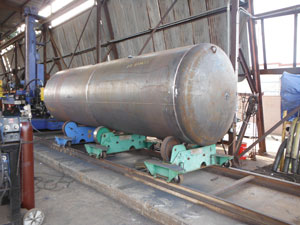Aggressive Procedures: Why Tank Welding Inspection Services Are Vital
Aggressive Procedures: Why Tank Welding Inspection Services Are Vital
Blog Article
Comprehensive Storage Tank Welding Inspection for Industrial Security and Regulatory Conformity
Guaranteeing commercial safety and regulative conformity within the world of tank welding evaluations is a critical element of keeping operational integrity and mitigating prospective threats. The meticulous evaluation of weld top quality, product thickness, and total tank condition is vital in safeguarding against ecological dangers and structural failures. By delving right into the details of comprehensive storage tank welding assessments, a much deeper understanding arises of the complex approaches employed to support market requirements and maintain safety and security procedures.
Relevance of Tank Welding Inspections
Conducting extensive and regular storage tank welding assessments is crucial in making sure the architectural stability, security requirements, and regulative compliance of industrial containers. These examinations play a critical duty in recognizing any type of prospective problems or weaknesses in the bonded joints that can jeopardize the overall honesty of the container. By finding these problems early, business can take proactive measures to resolve them immediately, thus preventing pricey repair services, environmental contamination, or, in the worst-case scenario, tragic failings.
Regular container welding assessments also aid organizations adhere to industry regulations and criteria set forth by authorities such as the American Oil Institute (API) or Occupational Security and Health Management (OSHA) Failure to satisfy these requirements can lead to fines, legal consequences, or even the suspension of procedures. Tank Welding Inspection Service. As a result, purchasing detailed tank welding examinations not just safeguards the wellness of personnel and the surrounding atmosphere but likewise protects the business's online reputation and bottom line in the future
Key Components of Weld Top Quality Assessment
Making certain the quality of welds includes a meticulous assessment of vital components that add to the architectural stability and reliability of industrial storage tanks. One critical aspect of weld high quality analysis is the examination of weld penetration. Appropriate penetration is crucial as insufficient penetration can cause weld issues and compromise the strength of the joint. Furthermore, the weld's profile need to be analyzed to make sure that it fulfills the specified requirements in terms of size and shape. The existence of any type of interruptions, such as splits, porosity, or insufficient combination, need to be extensively evaluated as these can damage the weld and increase the likelihood of failure. Furthermore, the overall weld appearance is also a vital component of top quality analysis, as it can show the visibility of issues or incongruities in the welding procedure. By adequately reviewing these crucial components, inspectors can aid assure that bonded joints satisfy the required standards for safety and regulatory conformity in commercial container building and construction.
Product Thickness Analysis Methods
In the context of weld top quality evaluation, an indispensable element to consider is the navigate here use of product thickness analysis methods. Exact measurement of product thickness is vital in guaranteeing the architectural stability and safety of bonded containers. Different non-destructive screening (NDT) methods are utilized for analyzing material thickness, consisting of ultrasonic screening, radiographic screening, and magnetic particle assessment. Ultrasonic screening involves the usage of high-frequency audio waves to determine material density by read here gauging the time considered the acoustic waves to travel with the product and mirror back. Radiographic testing utilizes X-rays or gamma rays to create photos revealing material thickness. Magnetic particle inspection is efficient for detecting surface and near-surface flaws that might influence material density. These strategies not just aid in evaluating the thickness of materials however likewise help in recognizing any kind of prospective issues or suspensions that might jeopardize the weld high quality and general stability of the container framework. By utilizing these product thickness assessment methods, markets can guarantee compliance with security requirements and policies, thus improving general operational security and dependability.
Container Condition Examination Approaches
An important aspect in keeping the integrity and security of bonded containers is the detailed exam of container problems through trusted evaluation methods. Tank problem assessment techniques play an important role in ensuring the architectural stability and operational effectiveness of industrial containers. Routine evaluations using these approaches are necessary for avoiding catastrophic failings and making sure the long-lasting reliability of bonded tanks.
Benefits of Routine Inspection Practices
Routine inspection methods not only protect versus prospective concerns discovered throughout tank problem examination techniques yet also act as proactive steps in maintaining the architectural integrity and functional efficiency of bonded containers. By conducting routine examinations, industrial facilities can recognize any indications of rust, splits, leaks, or other flaws in the container welds promptly. This early discovery makes it possible for prompt repairs or maintenance interventions, protecting against tiny issues from intensifying into bigger, a lot more pricey problems that could endanger safety or lead to regulative non-compliance.

Verdict

Finally, detailed container welding evaluations are essential for making sure commercial safety and regulative conformity. By conducting routine examinations and assessments of weld high quality, product density, and tank problem, organizations can determine possible risks and avoid expensive crashes. Implementing a proactive technique to examination practices can help maintain the structural honesty of tanks, safeguard the atmosphere, and make certain the safety and security of workers visit the site and the surrounding community.

Report this page